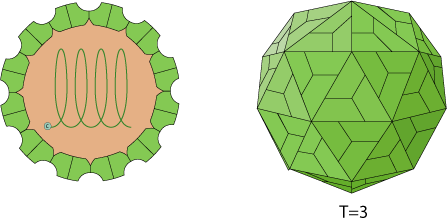Ilarvirus (taxid:12316)
VIRION

Non-enveloped, quasi-spherical virion about 29nm in diameter with T=3 icosahedral symmetry composed of 180 coat proteins: 12 pentamers and 20 hexamers.
GENOME
Segmented, tripartite linear ssRNA(+) genome composed of RNA1, RNA2, RNA3. Each genomic segment has a 3' tRNA-like structure and a 5'cap.
GENE EXPRESSION
Genomic RNA serves as messenger RNAs. RNA1 and RNA2 encode respectively proteins 1a and 2a, both involved in genome replication and internal transcription of sgRNA4 from the minus-strand copy of RNA3. RNA3 and sgRNA4 are translated respectively into movement and capsid proteins. ORF2b encodes a viral suppressor of RNA silencing (VSR) and is expressed as a subgenomic RNA (sgRNA4A).
ENZYMES
REPLICATION
CYTOPLASMIC
- Virus penetrates into the host cell.
- Uncoating, and release of the viral genomic RNA into the cytoplasm.
- Expression of protein 1a and 2a to produce replication proteins.
- Replication occurs in viral factories made of membrane vesicles derived from the ER (spherules). A dsRNA genome is synthesized from the genomic ssRNA(+).
- The dsRNA genome is transcribed/replicated thereby providing viral mRNAs/new ssRNA(+) genomes.
- Subgenomic RNA4 is translated producing capsid proteins.
- Assembly of new virus particles.
- Viral movement protein triggers the formation of tubular structures that mediate virion cell-to-cell transfer via a tubule-guided mechanism.
Host-virus interaction
Suppression of RNA silencing
Tobacco streak virus protein 2b possibly acts as a suppressor of RNA silencing.
Matching UniProtKB/Swiss-Prot entries
(all links/actions below point to uniprot.org website)5 entries grouped by strain
5 entries
Tobacco streak virus (strain WC) (TSV) reference strain
Blackberry chlorotic ringspot virus taxid:339420
Blueberry shock virus taxid:747056
Citrus leaf rugose virus taxid:37126
| Protein | ModelArchive |
| RNA-directed RNA polymerase 2a (EC 2.7.7.48) | ma-jd-viral-19248 |
Elm mottle virus taxid:56486
Fragaria chiloensis latent virus taxid:255238
Ilarvirus AGLV taxid:1386090
Ilarvirus ApMV taxid:12319
| Protein | ModelArchive |
| Coat protein | ma-jd-viral-27837 |
| Movement protein (Protein 3A) | ma-jd-viral-28738 |
Lilac leaf chlorosis virus taxid:722755
Parietaria mottle virus taxid:64958
| Protein | ModelArchive |
| Coat protein | ma-jd-viral-27551 |
| Movement protein (Protein 3A) | ma-jd-viral-27847 |
Privet ringspot virus taxid:2169960
Prune dwarf virus taxid:33760
| Protein | ModelArchive |
| Replication protein 1a | ma-jd-viral-38472 |
Prunus necrotic ringspot virus taxid:37733
| Protein | ModelArchive |
| Coat protein | ma-jd-viral-27833 |
| Movement protein (Protein 3A) | ma-jd-viral-28742 |
Spinach latent virus taxid:42680
Strawberry necrotic shock virus taxid:243563
| Protein | ModelArchive |
| 2b protein | ma-jd-viral-43707 |
| RNA-directed RNA polymerase 2a (EC 2.7.7.48) | ma-jd-viral-19125 |
Tobacco streak virus (strain WC) taxid:12318
| Protein | ModelArchive |
| RNA-directed RNA polymerase 2a (2a pol) (EC 2.7.7.48) (2a polymerase) | ma-jd-viral-19123 |
| Suppressor of silencing 2b (Protein 2b) | ma-jd-viral-43710 |
